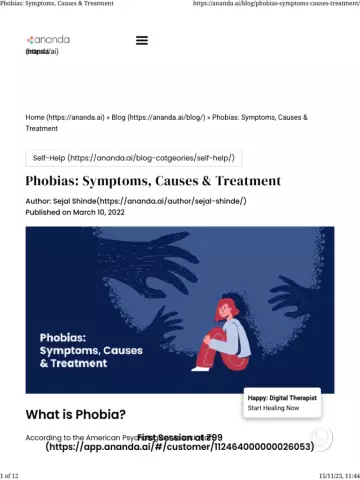- Author Rachel Wainwright [email protected].
- Public 2024-01-15 19:51.
- Last modified 2025-11-02 20:14.
Omphalitis
The content of the article:
- Causes and risk factors
-
Forms of the disease
- Simple (catarrhal) omphalitis
- Phlegmonous (purulent) omphalitis
- Necrotic (gangrenous) omphalitis
- Symptoms
- Diagnostics
-
Treatment
- Simple omphalitis
- Phlegmonous and necrotic omphalitis
- Possible complications and consequences
- Forecast
- Prevention
- Video
Omphalitis (from the Greek omphalos - navel) is an inflammation of the navel (the bottom of the navel, umbilical ring, adjacent tissue and blood vessels). It develops more often in newborns when the infection penetrates into an open umbilical wound, but it also occurs in adult patients.

Omphalitis develops with improper care of the umbilical wound
The ICD-10 disease code is P38.
Causes and risk factors
Omphalitis is considered a disease of newborns, since most often it is caused by infection of an unhealed umbilical wound. The umbilical wound forms after about a week after the birth of the baby, the remainder of the umbilical cord falls off, and heals within 10-14 days. Until the umbilical wound has healed, it must be looked after by regularly treating it with antiseptics. If the care is not carried out thoroughly, there is a risk of bacterial infection of the wound, infection penetrates into it and inflammation may develop.
A few decades ago, this disease was considered exclusively infantile, but nowadays omphalitis in adults is no longer considered a rarity. The reason for this is the fashion for umbilical piercing.
Infection can occur directly during the procedure if the puncture was carried out in improper conditions, with an insufficiently clean instrument, if the decoration placed at the puncture site was not sterile; as well as during the period of wound healing, if it was not properly looked after. In addition, a foreign object in the navel is a constant source of an increased risk of infection, since clinging to clothing can cause microtrauma to the skin of the navel, which serves as the entrance gate of infection.
Risk factors for omphalitis include poor hygiene and a weakened immune system.
Forms of the disease
There are three forms of omphalitis: simple (catarrhal), phlegmonous (purulent) and necrotic (gangrenous). They can also be seen as three successive stages. The most common is the catarrhal form, under unfavorable conditions it can turn into phlegmonous, and that, in turn, into necrotic. Severe forms of omphalitis pose a threat to the child's life.
Simple (catarrhal) omphalitis
This form of the disease is known under the names "weeping navel" and "fungus". Catarrhal inflammation is said when, after the umbilical cord has fallen off, the wound heals poorly, becomes covered with liquid serous or serous-purulent discharge (in such cases, they say that "the wound gets wet"), which, drying out, forms crusts. Coming off, the crusts, in turn, injure the surface even more. Sometimes in the umbilical wound the formation of granulations occurs - tuberous growths of tissue, resembling a mushroom in shape (hence the name "fungus", which means "mushroom").
The general condition of the child with this form of the disease does not suffer.
Phlegmonous (purulent) omphalitis
With phlegmonous omphalitis, the inflammation becomes purulent. The skin around the navel becomes swollen and hyperemic, the inflamed umbilical wound rises above the level of the abdomen. A purulent discharge comes out of the wound - it can be seen on the marks on the diaper (diaper), and can also be seen by lightly pressing the skin near the navel.
Purulent omphalitis is characterized by a deterioration in the general condition of the patient. The child becomes moody, symptoms of intoxication appear: impaired appetite, weight loss, anxiety. Body temperature rises to subfebrile values (37.5-38 ° C) with limited inflammation, and in the case of extensive phlegmon - to febrile (39-40 ° C) values.
Necrotic (gangrenous) omphalitis
This form of the disease develops only in very weak children with the addition of an aerobic infection. Purulent inflammation, characteristic of phlegmonous omphalitis, spreads deep into the umbilical tissues, while the surface tissues begin to die off. The skin in the area of the lesion acquires a maroon or dark bluish color, then blackens and is rejected with the formation of a wound surface. This is the most severe form of omphalitis, characterized by severe intoxication. At the same time, the child becomes lethargic, drowsy, he has no appetite, the body temperature is usually elevated, but it can be normal.
Symptoms
The main symptom of omphalitis is inflammation of the umbilical tissue.
| Disease form | Manifestations |
| Simple | The umbilical ring is hyperemic, edematous, the subcutaneous fatty tissue around it is infiltrated and compacted. The umbilical wound does not heal for a long time, a serous or serous-purulent exudate is released from it. The formation of fungus is possible - mushroom granulations in the navel. The general condition is unchanged. |
| Phlegmonous | The inflammation spreads to the tissues surrounding the navel, the umbilical wound is covered with fibrinous plaque, surrounded by a roller of compacted tissue, when pressed next to the umbilical wound, pus is released. At first, the inflammation is localized, then it is spilled - phlegmon is formed. The general condition suffers significantly, the temperature rises, signs of intoxication are expressed. |
| Necrotic | There is necrosis of the umbilical tissues, which can spread inward. The umbilical wound becomes dark burgundy, moist, a putrid smell emanates from it. The general state of health is disturbed. |
Diagnostics
Making a diagnosis in omphalitis usually does not cause difficulties, for this it is enough to examine the affected area, however, the diagnosis is carried out in order to determine the causative agents of infection, the degree (depth) of tissue damage in the phlegmonous and necrotic form, as well as the general condition of the body. The following studies are required:
- bacterial inoculation of inflammatory exudate from the umbilical wound with determination of the sensitivity of the pathogen (antibioticogram);
- clinical blood test;
- tests to detect a systemic inflammatory response (C-reactive protein, procalciotonin);
- Ultrasound of the abdominal cavity (with phlegmonous and necrotic omphalitis).
Treatment
Treatment tactics depend on the form of the disease.
Simple omphalitis
If there is no edema, and erythema does not capture the umbilical skin, but is limited only to the umbilical ring, no treatment is required, it is enough to adhere to the usual rules for caring for the umbilical wound. The care is as follows: after bathing the baby, treat the navel with a 3% solution of hydrogen peroxide, dry it with a clean cotton swab, apply a 1% alcohol solution of brilliant green or another antiseptic recommended by a pediatrician or a visiting nurse.

With simple omphalitis, antibiotic therapy is not required, antiseptic treatment of the umbilical wound is sufficient
In cases where catarrhal inflammation is accompanied by edema and significant redness covering the skin around the umbilical ring, the antiseptic treatment according to the scheme described above should be carried out four times a day.
Phlegmonous and necrotic omphalitis
Treatment of phlegmonous and necrotic forms of omphalitis is carried out in a hospital setting.
Until the results of the antibioticogram are obtained, antibiotics of a broad spectrum of action (aminoglycosides + penicillins) are prescribed parenterally, in the absence of a therapeutic effect within three days, second-generation cephalosporins are prescribed instead. After receiving the results of bacterial culture, the antibiotic is selected taking into account the sensitivity of the detected flora. For example, if methicillin-resistant Staphylococcus aureus is detected during bacterial culture, an antibiotic of the glycopeptide group is prescribed. Also, immunoglobulin therapy (immunosubstitution therapy), detoxification therapy is carried out.
Surgical intervention for phlegmonous omphalitis is performed to remove pus, the wound is washed, drainage is applied. With necrotizing omphalitis, surgical treatment consists of removing dead tissue.
Treatment of omphalitis in adults is carried out according to a similar scheme, except that the disease rarely passes into the stage of diffuse phlegmon, therefore hospitalization is usually not required, and the patient can carry out antiseptic treatment on his own.
Possible complications and consequences
A complication of catarrhal omphalitis can be the development of phlegmonous, and in severe cases, necrotic forms of the disease.
Severe complications of purulent and necrotizing omphalitis include the involvement of the umbilical vessels in the inflammatory process and the spread of the infection ascending with the development of portal and / or umbilical vein thrombosis, metastatic foci of purulent tissue fusion, portal hypertension, and liver abscess. In the case of generalization of infectious inflammation, sepsis develops.
Forecast
With timely treatment for medical care, the prognosis is favorable. In the absence of treatment, with an unfavorable development of events, phlegmonous and necrotizing omphalitis can be fatal.
Prevention
Prevention of omphalitis consists in strict adherence to the rules of antiseptics when caring for a newborn child:
- transection of the umbilical cord and processing of the umbilical cord in accordance with the regulated technique;
- dry care of the umbilical cord;
- teaching parents how to properly care for the umbilical wound;
- periodic monitoring of the correct care of the newborn by a patronage nurse.
Video
We offer for viewing a video on the topic of the article.

Anna Kozlova Medical journalist About the author
Education: Rostov State Medical University, specialty "General Medicine".
The information is generalized and provided for informational purposes only. At the first sign of illness, see your doctor. Self-medication is hazardous to health!






